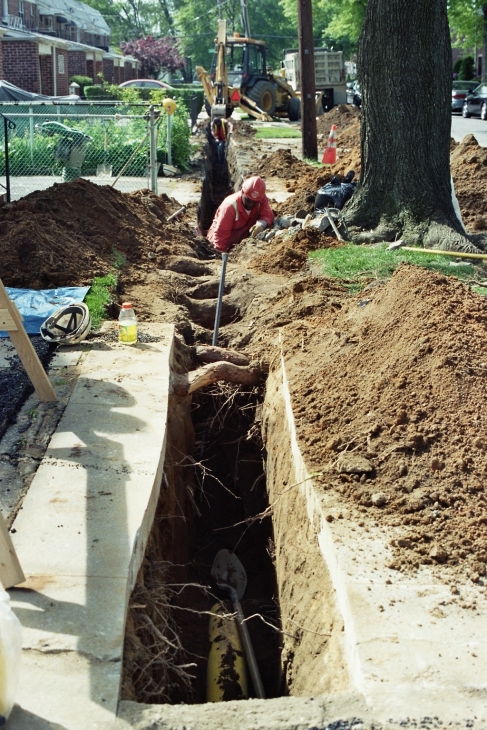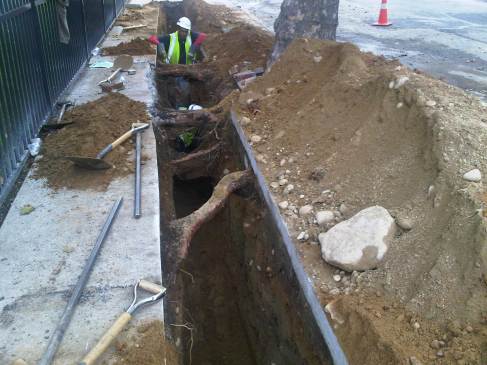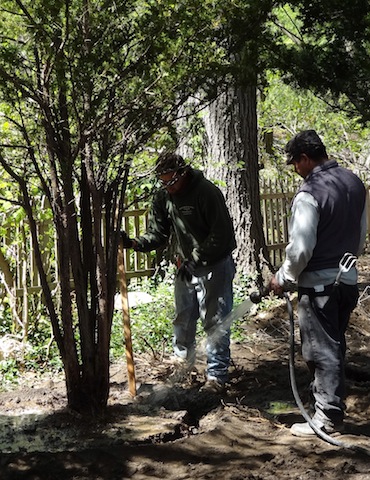The Massachusetts Arborists Association workshop on September 10, 2009, took place on a sunny, cool day at the Mass. Hort. Society’s headquarters at Elm Bank in Wellesley, MA.

Quite a few arborists and other landscape professionals attended the workshop, which began with slide talks and then moved outside to field demonstrations.
This workshop focused on root issues, with demonstrations of what some of those issues are — conflicts with utility lines, the effects of poor growing and planting practices, decline due to compacted and poor soils, and inappropriate tree locations — and how they may be remedied.
Rolf Briggs and Tree Specialists set up shop at a couple of different stations to show how they use air tools both to decompact soils and to excavate utility trenches near trees. The demonstrating arborists first discussed protective equipment, and showed what they use when they employ air tools: We watched as they put on respirators, helmets with face masks, ear protection, gloves, and either foul weather gear or jumpsuits — all necessary to protect from the great quantities of dust, soil, and stones blowing into the air.
To protect the surrounding area from flying detritus, Mike Hickman of Tree Specialists set up plywood or screen barriers around his work zone. I’ve seen plain plywood sheets used; the Tree Specialist guys have figured out that hinging several sheets together makes for a sturdier barrier, a good thing if you’re using air tools with any regularity in anything but a wide-open landscape.

Hinged plywood panels keep the dust contained to the area around a trench.

When it's necessary to dig a trench near a tree, air tools can do the job while preserving the tree's roots. You can see roots crossing this trench, but plenty of space beneath them for a new conduit or line. This trench was blown out with an air spade, and rocks and excess loose material after the blowing-out removed by hand.
The power of compressed air will break up soil move it out of the way; it can also damage roots to some extent, by blowing root bark or feeder roots entirely away. When using an air tool, experienced operators keep the nozzle moving to limit this kind of damage, and whenever possible (definitely not always possible in trenching work), they direct the air flow parallel to the direction of major root growth, away from the base of the tree.

Note the plywood barrier inside the trench as well, to focus the air blast and prevent soil from blowing into a previously blown-out section.

Blowing out the trench. This air tool is a new product that uses an auxiliary stream of water to help keep the roots hydrated and the dust down. Tree Specialists is assessing this new feature.
After blowing out a utility trench, Tree Specialists simply returns the native soil to the excavated area. They may add some amendments such as lime or humates, if they have already had soil tests done that indicate the need for such amendments. And to mulch the area once excavation and backfilling are complete, they have developed a proprietary mix of chipped and composted wood fibers (mainly from tree parts 3″ and less in diameter), twigs, and leaves. They use this same mix in their soil decompaction process, and note benefits to the trees from its use.
Mike Hickman pointed out that air tools break down soil aggregates and so obliterate soil structure in the area blown out. This breakdown can be considered a disadvantage of using compressed air for excavation; in Mike’s words, “Destruction of some of the soil aggregates I see as a “con,” but proper horticultural practices such as mulching and site specific amendments effectively mitigate these cons.”
Demonstrating arborist at this station:
Mike Hickman, Tree Specialists, Inc., Holliston, MA
Read Full Post »









